Scottish Health Survey 2015 - volume 1: main report
Findings and trends of the Scottish Health Survey 2015, providing information on the health of people living in Scotland.
7 Physical Activity
Peter Hovald
Summary
- Just under two-thirds (63%) of adults met the guideline for Moderate or Vigorous Physical Activity ( MVPA) in 2015, a similar level to that seen since 2012 (62-64%).
- Men (67%) were significantly more likely to meet the MVPA guideline than women (59%).
- Just over a quarter (26%) of adults met both the MVPA and muscle strengthening guidelines, with men being significantly more likely to do so than women (29% compared with 24%).
- The proportion of adults meeting both guidelines decreased with age, from 42% of those aged 16-24 to 7% of those aged 75 and over.
- Adults spent an average of 5.2 hours being sedentary on weekdays and 5.9 hours on weekend days, excluding time at work.
- In 2015, just under three-quarters (73%) of children met the guideline on physical activity (including school-based activity), a similar proportion to that seen in 2008 (71%).
- Boys (77%) were more likely to meet the guideline than girls (69%).
- The proportion of children meeting the guideline in 2012-2015 was significantly higher if their mother was active at the recommended level than if their mother was not. There was no significant difference according to whether their father met the recommendations or not.
- Around two-thirds (68%) of children had participated in sport in the prior week, a similar level to 2014 (67%) but lower than in 2008 (71%).
- Sports participation levels were comparable for boys (69%) and girls (66%).
- Children were sedentary for an average of 3.3 hours on weekdays and 4.5 hours on weekend days, excluding time at school or nursery.
7.1 Introduction
Being active is important for physical and mental health in many ways, including reducing the risk of over 25 chronic conditions including coronary heart disease, stroke, type 2 diabetes, cancer, obesity and musculoskeletal problems. It also has secondary prevention benefits for many other conditions [1] .
The benefits of being regularly active extend beyond physical health, with evidence that certain forms of increased activity may also improve mental wellbeing, another key health priority in Scotland. Exercise is now recommended by The Royal College of Psychiatrists as a treatment for depression in adults [3] , and the Scottish Intercollegiate Guidelines Network ( SIGN) national clinical guidelines for non-pharmaceutical management of depression states that structured exercise programmes may be an option for depressed people [4] .
Physical activity is particularly important for older people, helping people to live independently for longer. Many activities of daily living, such as getting out of a chair, or climbing stairs, do not necessarily require significant aerobic fitness, but do require strength and balance, which can also help reduce falls. Because older adults have the lowest physical activity levels of any age group and have the highest risk of disability, increasing physical activity in older adults is an important way to improve healthy life expectancy [5] . Being physically active and fit, among other factors, is related to better mental ageing [6] . High activity levels in childhood provide both immediate and longer-term benefits, for example by promoting cognitive skills and bone strength, reducing the incidence of metabolic risk factors such as obesity and hypertension, and setting in place activity habits that endure into adulthood, with evidence showing an association between sedentary behaviour and overweight and obesity [7] .
The World Health Organisation ( WHO) estimated, in 2008, that 3.2 million deaths per year could be attributed to low physical activity levels[8]. It is estimated that in Scotland low activity contributes to around 2,500 deaths per year and costs the National Health Service around £91 million annually [9] .
7.1.1 Policy background
Helping more people to be more active, more often is an over-arching policy objective of the Scottish Government. This commitment is reflected by the inclusion of a National Indicator to 'increase physical activity' in the National Performance Framework [10] . Data from the Scottish Health Survey ( SHeS) are used to monitor indicator performance. Physical activity is also relevant to a number of other National Performance Framework indicators, such as increasing active travel, improving levels of educational attainment, improving mental wellbeing and increasing the proportion of healthy weight children.
The Active Scotland Outcomes Framework[11], published in December 2014, sets out the Scottish Government's ambitions for a more active Scotland, describing the key outcomes desired for sport and physical activity in Scotland over the next ten years. Success will depend on the collective efforts of communities, individuals and a wide range of partners in areas such as health and social care, education, environment, transport, communities and sport and active recreation. A range of indicators track progress on the Active Scotland Outcomes Framework using data from SHeS.
The key national legacy programme designed to influence population levels of activity in adults and children is the national Physical Activity Implementation Plan: A More Active Scotland - Building a Legacy from the Commonwealth Games ( PAIP) [12] . The PAIP is a 10 year plan which adapts the key elements of the 2010 Toronto Charter for Physical Activity to Scotland, and links this directly to the Scottish Government's legacy ambitions for the Commonwealth Games [13] . The Toronto Charter was developed following extensive worldwide expert consultation and makes the case for increased action and greater investment in physical activity for health, environmental, economic and other wider outcomes.
Recognising the important role walking has in staying active, the Scottish Government launched its National Walking Strategy [14] in June 2014. The National Walking Strategy Action Plan was launched in March 2016.
Information on physical and sedentary activity collected during the survey is used to inform some of the intermediate-term indicators used to monitor the progress of the Obesity Route Map [15] .
The Active Scotland web portal , developed by NHS Health Scotland, helps physical activity staff and health professionals signpost the public to physical activity opportunities [16] . Key initiatives to tackle inactivity among children and young people include the Active Schools network, which aims to increase the number of sport and physical activity opportunities available to children to participate in sport before school, during lunch and after school [17] . Alongside this is the Sport Strategy for Children and Young People which aims to boost physical activity and participation and make sport as accessible and enjoyable as possible [18] .
Several programmes to increase physical activity have been designed to capitalise on the opportunities presented by the 2014 Commonwealth Games in Glasgow, Progress is being tracked via Assessing Legacy 2014 [19] . Through five rounds of awards, a total of 188 projects across Scotland received awards from the Legacy 2014 Active Places Fund, enabling communities to build, upgrade and improve facilities to drive participation in sport and physical activity.
7.1.2 Guidelines on physical activity
In July 2011, drawing on evidence about activity and health, the Chief Medical Officers of each of the four UK countries introduced revised guidelines on physical activity. The revisions followed guidance issued by the WHO and are in line with similar changes made to advice on activity levels in both the USA and Canada. The guidance, tailored to specific age groups over the life course, is as follows:
Table 7A UK CMOs' physical activity guidelines
| Age group | Guidelines |
| Early years - children under 5 years |
|
| Children and young people aged 5 to 18 |
|
| Adults aged 19-64 |
|
| Adults aged 65 and over |
|
7.1.3 Reporting on physical activity in the Scottish Health Survey ( SHeS)
Adult adherence to the new guidelines on moderate / vigorous physical activity ( MVPA) in 2015 is presented in this chapter along with the adherence to the guidance on doing muscle-strengthening activities at least two days a week and levels of sedentary time. Trends in child physical activity, both including and excluding school-based activities are also presented as are physical activity levels by parental physical activity. The trend in child participation in sports and exercise has also been updated and child sedentary levels in 2015 are also presented. As noted above, these headline measures are key indicators for a number of strategies.
Supplementary tables on physical activity are available on the survey website [20] .
7.2 methods And Definitions
7.2.1 Adult physical activity questionnaire
The SHeS questionnaire asks about four main types of physical activity:
- Home-based activities (housework, gardening, building work and DIY)
- Walking
- Sports and exercise, and
- Activity at work.
Information is collected on the:
- time spent being active
- intensity of the activities undertaken, and
- frequency with which activities are performed.
7.2.2 Adherence to adult physical activity guidelines
Monitoring adherence to the revised guidelines (discussed in Section 7.1.2) required several changes to be made to the SHeS physical activity questions in 2012. Details of the amendments made to the module, and fuller details of the information collected about physical activity, are outlined in the 2012 SHeS annual report [22] .
The current activity guidelines advise adults to accumulate 150 minutes of moderate activity or 75 minutes of vigorous activity per week or an equivalent combination of both, in bouts of 10 minutes or more. These guidelines are referred to throughout this chapter as the MVPA guidelines (Moderate or Vigorous Physical Activity). To help assess adherence to this guideline, the intensity level of activities mentioned by participants was estimated. Activities of low intensity, and activities of less than 10 minutes duration, were not included in the assessment. This allowed the calculation of a measure of whether each SHeS participant adhered to the guideline, referred to in the text and tables as "adult summary activity levels". A more detailed discussion of this calculation is provided in the 2012 report [22] .
Table 7B Adult summary activity levels a
| Meets MVPA guidelines | Reported 150 mins/week of moderate physical activity, 75 mins vigorous physical activity, or an equivalent combination of these. |
| Some activity | Reported 60-149 mins/week of moderate physical activity, 30-74 mins/week vigorous physical activity, or an equivalent combination of these. |
| Low activity | Reported 30-59 mins/week of moderate physical activity, 15-29 mins/week vigorous physical activity or an equivalent combination of these. |
| Very low activity | Reported less than 30 mins/week of moderate physical activity, less than 15 mins/week vigorous physical activity, or an equivalent combination of these. |
a Only bouts of 10 minutes or more were included towards the 150 minutes per week guideline
To avoid overcomplicating the text, where descriptions are provided of the summary activity levels, they tend to refer only to moderate physical activity, although the calculations were based on moderate or vigorous activity as described above.
A second summary measure was calculated for adults, in respect of meeting the guidelines to carry out activities that strengthen muscles on at least 2 days a week to increase bone strength and muscular fitness. Nine different sports were classed as always muscle strengthening, and other sports or exercises were classed as muscle strengthening if the participant reported that the effort was enough to make the muscles feel some tension, shake or feel warm. If the participant carried out such activities for at least 10 minutes on 2 or more days a week, on average, they were deemed to meet the muscle strengthening guideline. As this only includes muscle strengthening through sporting activity, reported levels may be an underestimate.
7.2.3 Child physical activity questionnaire
The questions on child physical activity are slightly less detailed than those for adults [23] . No information on intensity is collected (with the exception of asking those aged 13-15 about their walking pace). The questions cover:
- Sports and exercise
- Active play
- Walking, and
- Housework or gardening (children aged 8 and over only).
Children are asked to provide information on the average duration of sports and exercise activities for a typical weekday and typical weekend day. They are not asked to differentiate between different weekday or weekend days or to provide a specific duration for each separate day.
Since 2008, children at school have also been asked about any active things they have done as part of lessons (using the same format of questions as for all other activity types). Full details of all the information collected was provided in the 2012 report [22] .
7.2.4 Adherence to child physical activity guidelines
For the purposes of calculating physical activity levels, it was assumed that all reported activities were of at least moderate intensity. Data on each of the different activities have been summarised to provide an overall measure of child physical activity. This summary measure takes into account both the average time spent participating in physical activity, and the number of active days in the last week. Each child's level of physical activity was assigned to one of three categories:
Table 7C Child summary activity levels
| Meets guideline | Active on 7 days in last week for an average of at least 60 minutes per day |
| Some activity | Active on 7 days in last week for an average of 30 to 59 minutes per day |
| Low activity | Active on fewer than 7 days in last week or for an average of less than 30 minutes a day |
7.2.5 Sedentary activity
Since 2003, all participants aged 2 and over have been asked about time spent in front of a screen (e.g. a TV or computer) during leisure time on both weekdays and weekend days. For everyone aged 2 and over, questions about time spent sitting during leisure time (apart from in front of a screen) were added in 2012. The examples of time spent sitting that participants were given included eating, reading, studying and (for children) doing homework. For adults in paid work, new questions on time spent sitting during the working day were also added in 2012.
7.3 Adult Physical Activity Levels
7.3.1 Summary activity levels since 2012
In 2015, just under two-thirds (63%) of adults met the MVPA guidelines. Additionally, 12% of respondents reported some physical activity, 5% reported low levels, and 21% reported very low levels. Men were significantly more likely than women to meet the guidelines on physical activity in 2015 (67% compared with 59%), as in previous survey years.
Data on adherence to the current recommendation have been collected on the survey since 2012. The proportion of all adults meeting the guidelines has stayed relatively static from 2012 to 2015, ranging from 62-64% (63% in 2015). There was a significant increase in the percentage of men active at the recommended level between 2012 and 2013 (from 67% to 71%), which has since returned to the previous level (68% in 2014, 67% in 2015). Levels have remained similar for women across the same overall period (58% in 2012 and 2013, 59% in 2014 and 2015), as shown in Figure 7A.
Figure 7A, Table 7.1
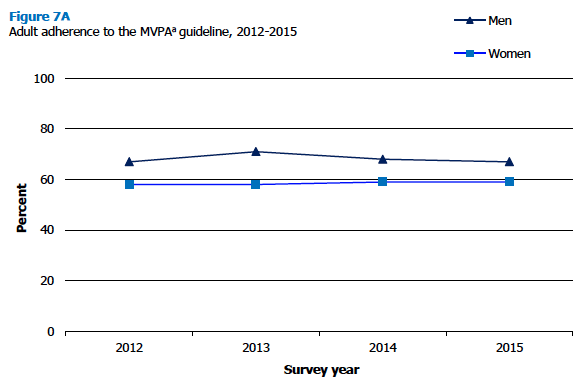
a Meets moderate / vigorous physical activity guidelines of 150 minutes of moderate, or 75 minutes‟ vigorous activity, or combination of both each week
7.3.2 Adherence to muscle strengthening and MVPA guidelines in 2015
SHeS collects data on adherence to guidelines on muscle strengthening activities (performing muscle strengthening exercises on at least two days per week). In 2015, just over a quarter (26%) of adults aged 16 and over met both the muscle strengthening and MVPA guidelines, with 1% meeting the muscle strengthening guideline only. Just over a third (36%) met the MVPA guideline but not the recommended level of muscle strengthening activity. The remaining 36% of adults met neither guideline.
Whether adults were male or female was significantly associated with activity levels. In 2015, men were significantly more likely than women to meet both the MVPA and muscle strengthening guideline (29% for men compared with 24% for women) and less likely to meet neither guideline (32% and 40% respectively). There was no significant difference between the proportion of men (38%) and women (35%) who met the MVPA guidelines only.
In 2015, the proportion of adults meeting both the MVPA and muscle strengthening guidelines declined with age, from 42% of those aged 16-24 to 7% of those aged 75 and over. Those meeting neither guideline increased with age, from just under a quarter (23%) of those aged 16-24 to just over two-thirds (68%) of those aged 75 and over. Similar patterns were seen for both men and women, with adherence to both guidelines declining from those aged 16-24 to those aged 75 and over (47% to 10% for men, 37% to 5% for women) and adherence to neither guideline increasing across the same age groups (21% to 56% for men, 25% to 76% for women).
7.3.3 Adults' sedentary time in 2015
The Scottish Government advises adults to avoid extended periods of sedentary time. In 2015, SHeS collected data regarding the amount of time adults spent being sedentary on both weekdays and on weekends. Figures 7B, 7C and Table 7.3 show the average number of hours that adults in Scotland spent sitting (including TV and non- TV hours) per weekday and weekend day by sex and age, excluding time spent at work.
In 2015, adults in Scotland spent an average of 5.2 hours being sedentary on weekdays and 5.9 hours on weekend days, excluding time spent at work. The average time men spent being sedentary was significantly higher than for women both on weekdays (5.3 hours compared with 5.1) and weekend days (6.1 hours compared with 5.8 hours).
Sedentary activity patterns by age in 2015 were the same on weekdays and weekend days. Sedentary levels declined from those aged 16-24 (5.6 hours on weekday, 6.2 on weekends) to those aged 35-44 (4.0 hours and 5.0 hours respectively) before increasing with age. Those aged 75 and over sat for the greatest amount of time, on average, on both weekdays and weekend days (7.2 hours and 7.4 hours respectively). Sedentary activity patterns by age were similar for men and women.
Figure 7B, Figure 7C, Table 7.3
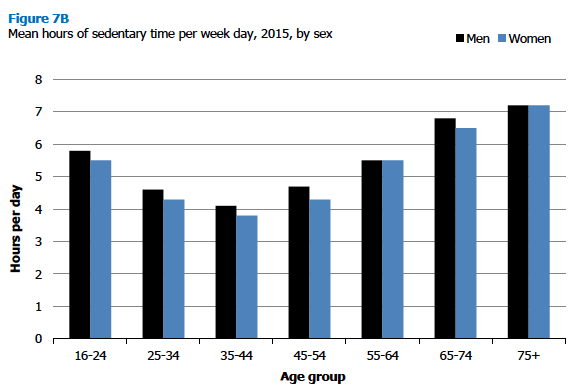
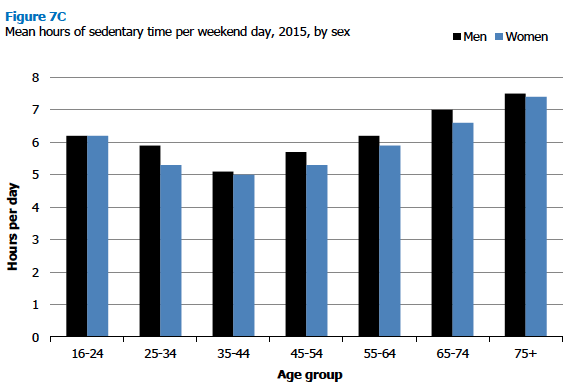
7.4 Child Physical Activity Levels
7.4.1 Proportion of children meeting physical activity guideline since 1998
SHeS has collected data on child physical activity levels since 1998, with school-based activity reported on since 2008. Figure 7D and Table 7.4 show the proportion of children aged 2-15 years reporting sufficient physical activity to meet the guidelines across this time period.
As shown in Figure 7D, around three quarters (73%) of children met the guideline on physical activity (including school activity) in 2015, with boys (77%) being significantly more likely to do so than girls (69%). When school-based activity is excluded, around two thirds (66%) were active at the recommended level with the proportion of boys (71%) significantly higher than the proportion of girls (61%).
Trends in physical activity for all children have fluctuated over the years but are similar in 2015 and 2008 both when school-based activities are included (73% meeting guidelines in 2015 compared with 71% in 2008) and when they are excluded (66% and 64% respectively).
While figures for boys were similar in 2008 and 2015 (77% in both when school-based activity included, 72% in 2008 and 71% in 2015 when school-based activity excluded) there has been more fluctuation in physical activity levels for girls. Levels of physical activity rose from 2008 to a peak in 2014 and then stayed at statistically similar levels in 2015, with this being the case both when school-based activity was included (64%, 73% and 69%) and when it was excluded (56%, 67% and 61%).
Figure 7D, Table 7.4
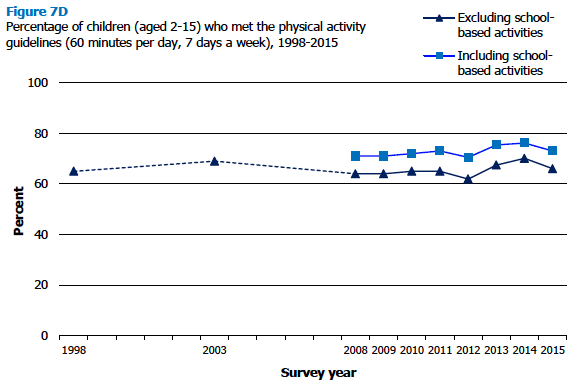
7.4.2 Summary of children's physical activity by parental physical activity, 2012-2015 (combined)
To increase the sample size available, detailed analysis of children's physical activity by parental physical activity levels used data from the 2012, 2013, 2014 and 2015 surveys combined.
The 2012-2015 data shows that the proportion of children meeting the physical activity recommendation was significantly higher if their mother was active at the recommended level (78% of children) than if they were not (68% of children). This was the case both when the children were boys (82% meeting recommended levels if their mother met the guidelines compared with 71% doing so if their mother did not) and when they were girls (73% compared with 65% respectively).
There was no significant difference in children's physical activity according to whether their father met the recommended levels or not. In 2012-2015, 75% of children reached the guidelines if they had a father who met their recommended level and 72% of children met the guidelines if their father did not. Data by sex of child showed a similar pattern, with no significant difference between either boys (81% meeting the guidelines if their father met the guidelines compared with 75% if their father did not) and girls (69% and 70% respectively).
Figure 7E, Table 7.5
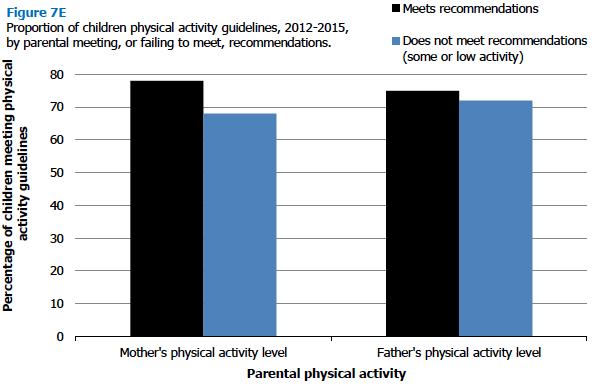
7.4.3 Proportion of children participating in sport since 1998
SHeS collects data on the proportion of children who report taking part in sport in the week prior to being interviewed. These data, collected in 1998, 2003 and then annually since 2008, are displayed in Figure 7F.
In 2015 around two-thirds (68%) of children aged 2-15 participated in sport in the week prior to interview, with there being no statistically significant difference between boys (69%) and girls (66%).
Levels of participation in sport for children aged 2-15 have tended to fluctuate over the years, with a decline between 2008 (71%) and 2012 (66%) before stabilising at a similar level in later years (67% in 2013 and 2014, 68% in 2015). Participation patterns over the years have been largely comparable for both sexes, with similar levels in 2015 to those in 2012 for both boys (69% in 2015 compared with 67% in 2012) and girls (66% and 65% respectively).
Figure 7F, Table 7.6
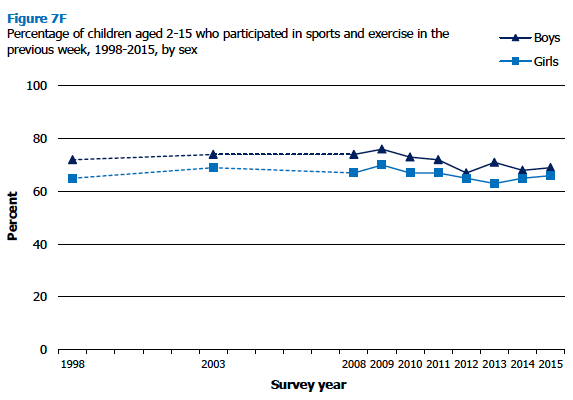
7.4.4 Children's sedentary time in 2015
As with adults, SHeS 2015 also collected data on the amount of time children aged 2-15 spent being sedentary (including both TV and non- TV time), excluding time at school or nursery. In 2015, children spent an average of 3.3 hours being sedentary on weekdays and 4.5 hours on weekend days. Levels of sedentary activity did not vary significantly between boys and girls either on weekdays (3.2 hours for boys compared with 3.3 for girls) or on weekends (4.6 hours and 4.4 hours respectively).
In 2015, the amount of sedentary time reported was associated with age. Children aged 11-15 reported a greater amount of time spent being sedentary on weekdays (3.8-4.2 hours on average) than those aged 2-10 (2.9-3.0 hours). A similar pattern was observed for weekend days with those aged 11-15 spending 5.2-5.6 hours being sedentary and those aged 2-10 spending 3.8-4.4 hours.
Figure 7G, Figure 7H, Table 7.7
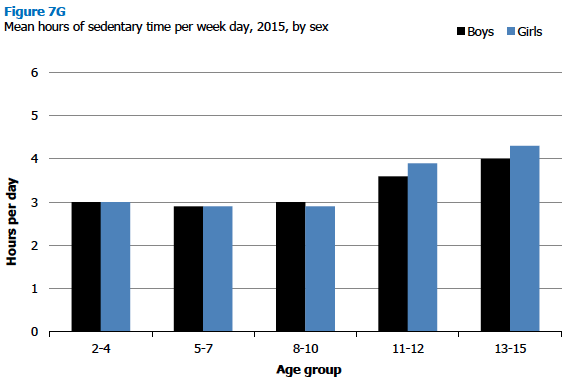
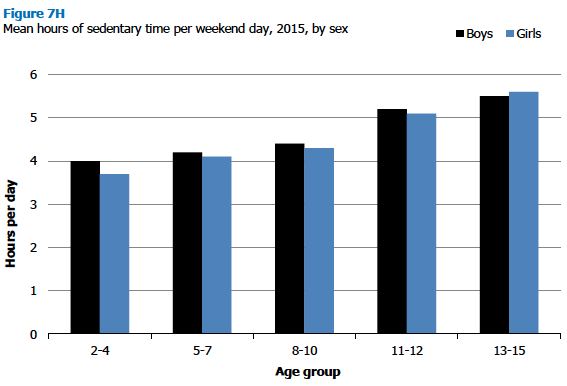
Contact
Email: Julie Landsberg, julie.landsberg@gov.scot
There is a problem
Thanks for your feedback